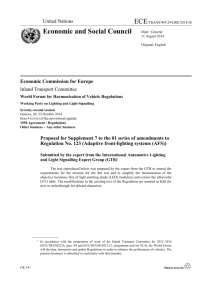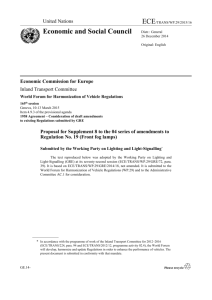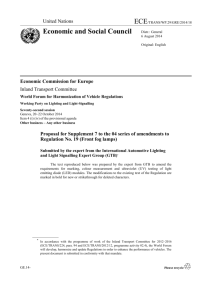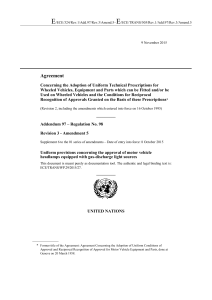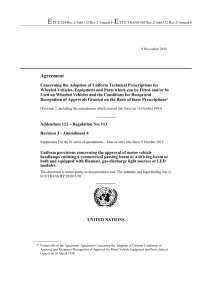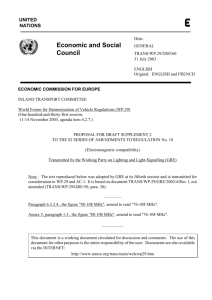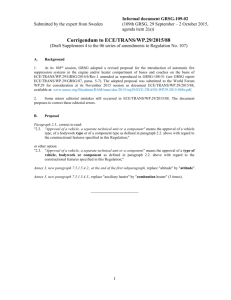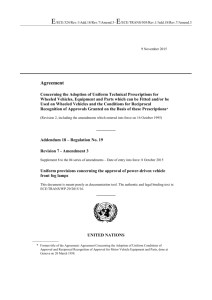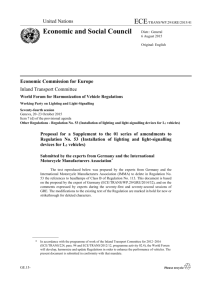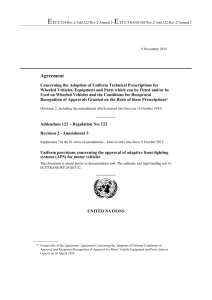United Nations
advertisement
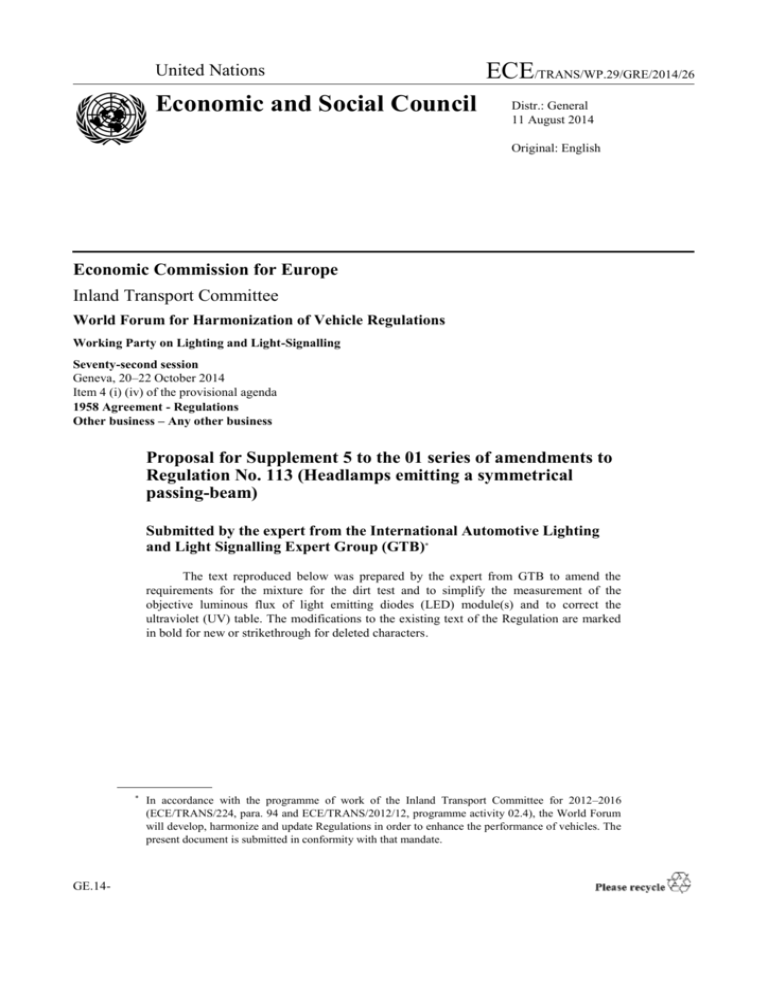
United Nations Economic and Social Council ECE/TRANS/WP.29/GRE/2014/26 Distr.: General 11 August 2014 Original: English Economic Commission for Europe Inland Transport Committee World Forum for Harmonization of Vehicle Regulations Working Party on Lighting and Light-Signalling Seventy-second session Geneva, 20–22 October 2014 Item 4 (i) (iv) of the provisional agenda 1958 Agreement - Regulations Other business – Any other business Proposal for Supplement 5 to the 01 series of amendments to Regulation No. 113 (Headlamps emitting a symmetrical passing-beam) Submitted by the expert from the International Automotive Lighting and Light Signalling Expert Group (GTB)* The text reproduced below was prepared by the expert from GTB to amend the requirements for the mixture for the dirt test and to simplify the measurement of the objective luminous flux of light emitting diodes (LED) module(s) and to correct the ultraviolet (UV) table. The modifications to the existing text of the Regulation are marked in bold for new or strikethrough for deleted characters. * GE.14- In accordance with the programme of work of the Inland Transport Committee for 2012–2016 (ECE/TRANS/224, para. 94 and ECE/TRANS/2012/12, programme activity 02.4), the World Forum will develop, harmonize and update Regulations in order to enhance the performance of vehicles. The present document is submitted in conformity with that mandate. ECE/TRANS/WP.29/GRE/2014/26 I. Proposal Annex 4, paragraph 1.2.1.1., amend to read: “1.2.1.1. Test mixture 1.2.1.1.1. For headlamp with the outside lens in glass: The mixture of water and a polluting agent to be applied to the headlamp shall be composed of: 9 parts by weight of silica sand with a particle size of 0-100 μm, 1 part by weight of vegetal carbon dust produced from (beech wood) with a particle size of 0-100 μm, 0.2 parts by weight of NaCMC3, and 5 parts by weight of sodium chloride (pure at 99 per cent), an appropriate of 1 mS/m. quantity of distilled water, with a conductivity The mixture must not be more than 14 days old. 1.2.1.1.2. For headlamp with outside lens in plastic material: The mixture of water and polluting agent to be applied to the headlamp shall be composed of: 9 parts by weight of silica sand with a particle size of 0-100 μm, 1 part by weight of vegetal carbon dust produced from (beech wood) with a particle size of 0-100 μm, 0.2 part by weight of NaCMC3, 5 parts by weight of sodium chloride (pure at 99 per cent), 13 parts by weight of distilled water with a conductivity of 1 mS/m, and 2 1 parts by weight of surface-actant4. The mixture must not be more than 14 days old.” Annex 12, paragraph 4.2., table UV, amend to read: “Table UV Values according to "IRPA/INIRC Guidelines on limits of exposure to ultraviolet radiation". Wavelengths (in nanometres) chosen are representative; other values should be interpolated. 2 S() S() S() 250 0.430 305 0.060 355 0.000 16 255 0.520 310 0.015 360 0.000 13 260 0.650 315 0.003 365 0.000 11 265 0.810 320 0.001 370 0.000 09 270 1.000 325 0.000 50 375 0.000 077 275 0.960 330 0.000 41 380 0.000 064 ECE/TRANS/WP.29/GRE/2014/26 280 0.880 335 0.000 34 385 0.000 530 0.000 053 285 0.770 340 0.000 28 390 0.000 044 290 0.640 345 0.000 24 395 0.000 036 295 0.540 350 0.000 20 400 0.000 030 300 0.300 “ Annex 12, paragraph 5.2., amend to read: “5.2. Three One modules of each type shall be submitted by the applicant with the light source control gear, if applicable, and sufficient instructions. Suitable thermal management (e.g. heat sink) may be provided, to simulate similar thermal conditions as in the corresponding headlamp application. Before the test the each LED module shall be aged at least for seventy-two hours under the same conditions as in the corresponding headlamp application. In the case of use of an integrating sphere, the sphere shall have a minimum diameter of one meter, and at least ten times the maximum dimension of the LED module, whichever is the largest. The flux measurements can also be performed by integration using a goniophotometer. The prescriptions in CIE Publication 84 - 1989, regarding the room temperature, positioning, etc., shall be taken into consideration. The LED module shall be burned in for approximately one hour in the closed sphere or goniophotometer. The flux shall be measured after stability has occurred, as explained in paragraph 4.3.1.2. of this annex. The average of the measurements of the three samples of each type of LED module shall be deemed to be its objective luminous flux.” II. Justification Amendment to Annex 4, paragraph 1.2.1.1. 1. The Regulations currently specify several test mixtures to simulate dirt during testing of lamps. As there is no reason to use different kinds of test mixtures it is proposed to amend the Regulations by introducing a uniform test mixture to be used for all the tests. In addition, to avoid misinterpretation, the wording “beech wood” is replaced by “produced from beech wood”. Amendment to Annex 12, paragraph 4.2. 2. This is a correction to the UV test table. Amendment to Annex 12, paragraph 5.2. 3. This proposal intends to simplify the test procedures that determine the objective luminous flux of LED module(s). As the purpose of this test is to verify that the luminous flux is greater than 1000 lm; it is not required to measure an absolute value, it is sufficient 3 ECE/TRANS/WP.29/GRE/2014/26 to perform this measurement on one LED module instead of on three modules as currently required. 4
